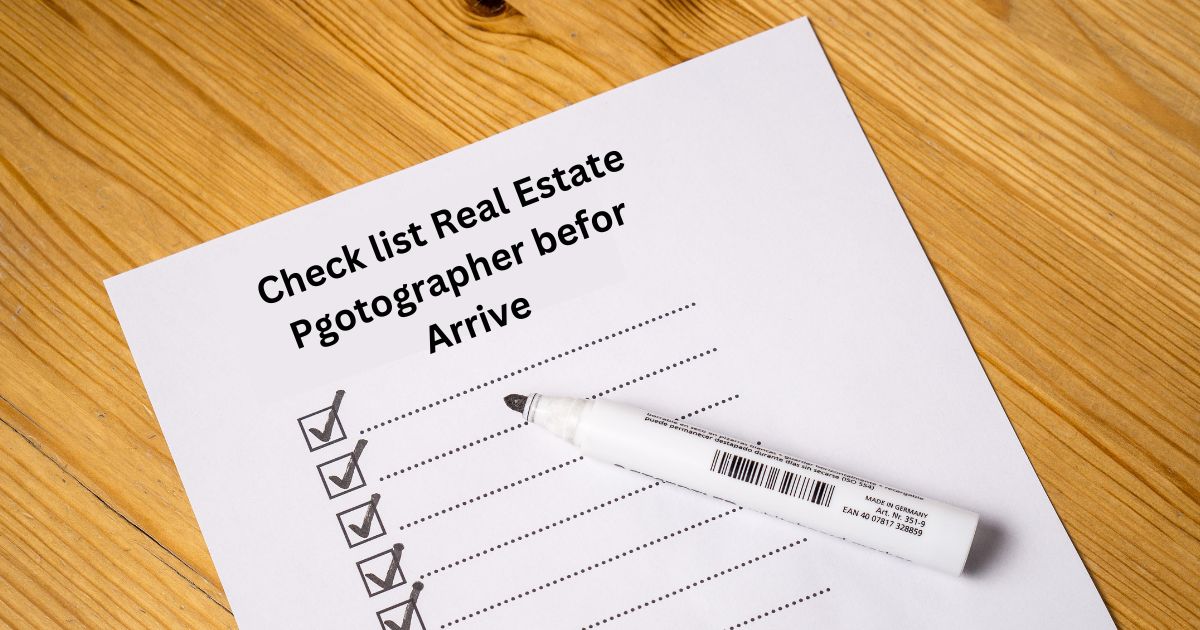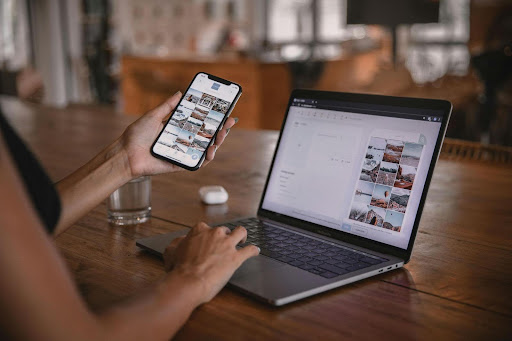In the competitive world of real estate photography, preparation is key to capturing stunning images that highlight the best features of a property. A well-prepared real estate photographer can make a significant difference in showcasing a home effectively, which in turn can attract potential buyers and close deals faster. This article provides an in-depth Check list Real Estate Pgotographer befor Arrive to ensure you’re fully prepared before arriving at the property. By following these guidelines, you’ll be able to streamline your process, avoid common pitfalls, and produce high-quality images that stand out in a crowded market.
Understanding the Property
Before you set foot on the property, it’s crucial to have a clear understanding of what you’re photographing. Every property is unique, with its own set of characteristics that will influence how you approach the shoot. Start by gathering detailed information about the property type—whether it’s a residential home, commercial space, or luxury estate. Note the architectural style, the layout, and any distinctive features that should be highlighted. Understanding these elements will help you tailor your photography approach to capture the property in the best possible light, emphasizing its strengths and minimizing any weaknesses.
Communicating with the Client
Effective communication with the client is essential for a successful real estate photoshoot. Reach out to the client to discuss their expectations and any specific requests they might have. This includes confirming the shoot date, time, and location, as well as discussing any special features or rooms that they want to be prominently featured. Clear communication helps set expectations and ensures that both you and the client are on the same page regarding the final outcome of the photoshoot. It also provides an opportunity to address any questions or concerns that might arise, leading to a smoother and more efficient shoot.
Scouting the Location in Advance
Visiting the property before the day of the shoot can offer numerous benefits. A preliminary visit allows you to assess the property’s layout, lighting conditions, and potential shooting angles. It also provides a chance to identify any challenges or obstacles that may affect your shoot, such as cluttered spaces or difficult lighting. During this scout, take notes and photographs of key areas, and develop a plan for how you’ll approach the shoot. This advance preparation helps streamline the actual photoshoot, allowing you to work more efficiently and effectively on the day of the shoot.
Weather Considerations
Weather conditions can significantly impact real estate photography, especially for properties that rely heavily on natural light. Before the shoot, check the weather forecast to ensure that conditions will be favorable for your planned shoot. For outdoor properties or those with large windows, sunny weather is often ideal, while overcast conditions might be preferred for softer lighting. Have a backup plan in place for adverse weather conditions, such as rescheduling the shoot or using artificial lighting to compensate for the lack of natural light. Being prepared for various weather scenarios ensures that your shoot can proceed smoothly regardless of external conditions.
Essential Gear Checklist
Having the right gear is crucial for capturing high-quality real estate photos. Start by ensuring you have your primary camera and lenses, including wide-angle lenses that are essential for showcasing rooms and spaces. A tripod is also important for maintaining stability and consistency, particularly in low-light conditions. Additional gear such as a drone can be useful for aerial shots of the property, while lighting equipment can help enhance indoor photography. Make a checklist of all the equipment you’ll need, and double-check that everything is in working order before you leave for the shoot.
Also Read: How to Wean Knock the Door with Any Service Suggestions
Camera Settings for Real Estate Photography
Proper camera settings are essential for achieving the best results in real estate photography. For interior shots, use a low ISO setting to minimize noise and ensure sharp images. A small aperture (e.g., f/8 or f/11) helps to keep the entire room in focus, while a slower shutter speed can be used to capture more light in darker areas. For exterior shots, consider adjusting your settings based on the time of day and lighting conditions to achieve the desired effect. Using a tripod is crucial for maintaining stability and avoiding blurriness, particularly in low-light situations.
Lighting Preparation
Lighting plays a significant role in real estate photography, and proper preparation is key to achieving the best results. Natural light is often preferred for its ability to create a warm and inviting atmosphere. However, you may need to supplement natural light with artificial lighting to fill in shadows and highlight specific features. Use soft, diffused lighting to avoid harsh shadows and create a balanced look. When shooting interiors, consider using multiple light sources to evenly illuminate the space and enhance its appeal. Experiment with different lighting setups during your scouting visit to determine the best approach for the property.
Drone Photography Preparation
Drone photography can provide unique and compelling perspectives of a property, especially for larger estates or properties with significant outdoor features. Before using a drone, ensure that you are familiar with local regulations and have the necessary permits if required. Check that your drone is fully charged and in good working condition, and review any safety protocols to ensure a smooth operation. Plan your aerial shots in advance, considering the best angles and heights to showcase the property’s features effectively. Drone photography can add a dramatic and professional touch to your real estate portfolio, setting your work apart from the competition.
Ensuring a Clean and Decluttered Space
A clean and decluttered space is essential for achieving high-quality real estate photos. The Check list Real Estate Pgotographer befor Arrive should include advising your client on how to prepare the property by removing personal items, excessive decorations, and any clutter that could distract from the property’s features. Encourage them to tidy up areas such as countertops, floors, and closets to create a more polished and appealing look. A well-prepared space not only enhances the visual appeal of the property but also helps potential buyers envision themselves in the home. Providing clients with clear guidelines on how to prepare can lead to better results and a more efficient photoshoot.
Staging Tips for Real Estate Photography
Staging can make a significant difference in how a property is perceived in photographs. Simple staging techniques, such as arranging furniture to create a sense of flow and balance, can enhance the overall look of the space. Consider adding fresh flowers or strategically placed accessories to make the home look inviting and well-maintained. For properties that may benefit from additional visual appeal, virtual staging can be a useful option. Virtual staging involves digitally adding furniture and decor to photos, allowing potential buyers to visualize the property’s potential without physical staging. Whether using traditional or virtual staging, the goal is to present the property in its best light.
Framing and Composition Considerations
Framing and composition are critical elements in real estate photography that can greatly impact the final images. Follow basic rules of composition, such as the rule of thirds, to create balanced and visually appealing photos. When photographing rooms, capture wide-angle shots that showcase the space and flow, avoiding distortion that can occur with overly wide lenses. Pay attention to lines and angles to ensure that vertical and horizontal elements appear straight and aligned. By focusing on effective framing and composition, you can highlight the property’s features and create images that are both engaging and informative.
Handling Reflections and Mirrors
Reflections and mirrors can present challenges in real estate photography, often resulting in unwanted elements appearing in the shots. To avoid unwanted reflections, position yourself carefully and adjust your camera angle to minimize reflections from windows, mirrors, or other reflective surfaces. Use polarizing filters to reduce glare and reflections when photographing highly reflective surfaces. If reflections are unavoidable, consider using them creatively to add depth and interest to your photos. Handling reflections effectively ensures that the final images are clean, professional, and free from distracting elements.
Importance of a Shot List
A well-prepared shot list is essential for ensuring that you capture all necessary angles and features of the property. Create a comprehensive shot list before the shoot, including specific areas such as living rooms, kitchens, bedrooms, and bathrooms. Include details on any unique features or selling points that should be highlighted. A shot list helps you stay organized and ensures that no important details are missed during the photoshoot. It also provides a clear roadmap for your shoot, allowing you to work more efficiently and effectively, and ultimately producing a well-rounded set of images for the client.
Time Management on the Shoot Day
Effective time management is crucial for a smooth and successful real estate photoshoot. Allocate specific time slots for each room or area of the property to ensure that you capture all necessary shots without feeling rushed. Plan your shoot schedule around the best lighting conditions, and allow time for adjustments or retakes if needed. Keeping track of time and sticking to a schedule helps you stay organized and ensures that you make the most of your time on-site. By managing your time efficiently, you can produce high-quality images while minimizing stress and avoiding delays.
Final Equipment Check Before Departure
Before heading to the property, conduct a final equipment check to ensure that everything is in working order. Verify that your camera, lenses, tripod, and any additional gear are packed and functioning correctly. Check battery levels and bring spare batteries to avoid running out of power during the shoot. Ensure that you have sufficient memory cards and that they are formatted and ready for use. A thorough equipment check helps prevent technical issues and ensures that you are fully prepared for the photoshoot, allowing you to focus on capturing great images.
On-Arrival Checklist
Upon arriving at the property, follow an on-arrival checklist to ensure that everything is set up for a successful shoot. Start by inspecting the property to identify any immediate issues or adjustments that need to be made. Set up your equipment and make any necessary adjustments to the lighting and camera settings. Review your shot list and plan your shooting sequence based on the property’s layout and lighting conditions. By following a structured on-arrival checklist, you can efficiently prepare for the shoot and ensure that you capture all the key features of the property.
Post-Shoot Review and Backup
After completing the photoshoot, conduct a post-shoot review to ensure that all desired shots have been captured. Check your images on-site to confirm that you have the necessary coverage and quality. Backup your photos immediately to prevent data loss, using multiple storage devices or cloud services. A post-shoot review helps identify any missing shots or issues that may need to be addressed, while backing up your images ensures their safety and security. Taking these steps after the shoot helps ensure that your work is preserved and ready for editing.
Editing and Post-Processing Considerations
Editing and post-processing are essential steps in real estate photography that can enhance the overall quality of your images. Use photo editing software to adjust lighting, color balance, and sharpness, and to correct any distortions or imperfections. Consider retouching to remove minor blemishes or distractions that may detract from the property’s appeal. Maintain a consistent editing style to ensure that all photos in the set have a cohesive look. Effective editing and post-processing can significantly improve the visual impact of your images, making them more appealing to potential buyers.
Conclusion
Preparation is the cornerstone of successful real estate photography, and following a detailed Check list Real Estate Pgotographer befor Arrive ensures that you are well-equipped to capture stunning images of any property. By understanding the property, communicating effectively with the client, and preparing thoroughly, you set yourself up for a successful photoshoot that highlights the property’s best features. From gear and lighting to editing and post-processing, each step in the Check list Real Estate Pgotographer befor Arrive plays a vital role in achieving high-quality results. Embrace these best practices to enhance your photography skills, deliver exceptional images, and stand out in the competitive real estate market.










